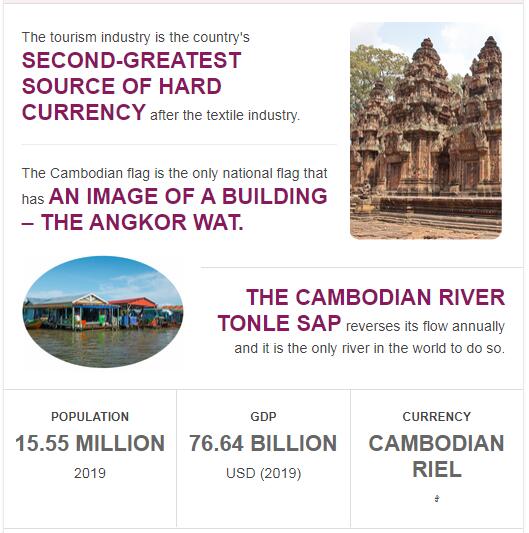The population of Cambodia in 2017 was 16.2 million people, with the majority of the population living in rural areas. The economy of Cambodia is largely based on agriculture, with a GDP of $25 billion and a relatively low per capita income. Cambodia is a member of the United Nations, Association of Southeast Asian Nations (ASEAN), World Trade Organization (WTO) and Asia-Pacific Economic Cooperation (APEC). It has close ties to many countries throughout Asia as well as China. In terms of politics, Cambodia is a unitary constitutional monarchy with King Norodom Sihamoni as its head of state. The Prime Minister is Hun Sen who leads the Cambodian People’s Party which has been in power since 1985. See militarynous for Cambodia military and defense.
Yearbook 2017
Cambodia. According to Countryaah.com, the government and the ruling Cambodian People’s Party (CPP) increased pressure on the opposition and individual organizations as well as the media during the year.
Concerns nevertheless, the World Bank reported that growth in 2016 was 7% and would be close to that level in 2017 and 2018. This despite a slowdown in the export of textiles and the construction sector, but other manufacturing and tourism contributed to the economy. China was Cambodia’s most important donor and investor. See ABBREVIATIONFINDER for frequently used acronyms and abbreviations related to as well as country profile of Cambodia.

Economy
| Inflation rate | 2.90% |
| Unemployment rate | , 3% |
| Gross domestic product (GDP) | $ 64,210,000,000 |
| GDP growth rate | 6.90% |
| GDP per capita | 4,000 USD |
| GDP by sector | |
| Agriculture | 25.30% |
| Industry | 32.80% |
| Service | 41.90% |
| State budget | |
| Revenue | 836.2 million |
| Expenditure | 978.7 million |
| Proportion of the population below the national poverty line | 20% |
| Distribution of household income | |
| Top 10% | 37.3 |
| Lower 10% | 3 |
| Industrial production growth rate | 8.30% |
| Investment volume | 20.8% of GDP |
| National debt | 30.40% of GDP |
| Foreign exchange reserves | $ 11,290,000,000 |
| Tourism | 2014 |
| Number of visitors | 4,503,000 |
| Revenue | 3,220,000,000 USD |
Sam Rainsy, leader of the largest opposition party CNRP (Cambodia’s National Rescue Party), resigned in February. He has lived in exile for several years and has been threatened by several legal processes. The departure was seen as an attempt to ward off a ban on the party. Kem Sokha took over as party and opposition leader.
In February, the CNRP boycotted a vote in which Parliament gave the Supreme Court and the Interior Ministry the opportunity to dissolve political parties. Nor did people convicted of crimes get a candidate. The writing was considered directed at Rainsy, who was previously sentenced to two years in prison in a contentious prosecution case.
At the June local elections – which was seen as a kind of trial before the 2018 parliamentary elections – CNRP went ahead and won power in almost 30% of the more than 1,600 municipalities. The mood before and during the election was described as threatening and long-standing Prime Minister Hun Sen made frantic results.
In September, Kem Sokha was arrested for alleged cooperation with the United States to overthrow the government. He risks 30 years in prison. In the wake of Kem Sokha’s arrest, some 20 of the CNRP’s 55 MPs went into exile.
The Supreme Court, whose independence was challenged, announced in November that CNRP would be banned. The ban lasts for five years and removes the only real challenger to Hun Sens’s party. CNRP’s seats in parliament and municipalities should be distributed among other parties, including the royalist FUNCINPEC. The decision was criticized by international donors and a number of countries, including Sweden who also announced that the cooperation with Cambodia would be reviewed. UN Special Rapporteur for Cambodia, Rhona Smith, warned that the country was on its way to becoming a one-party state.
Shortly thereafter, in a speech before textile workers, Hun Sen demanded that the human rights group CCHR (Cambodian Center for Human Rights) should be closed because it was created by foreigners. The group was formed in 2002 by Kem Sokha, but CCHR stated that he left the management in 2007. The group claims to be independent.
At the end of the year, Hun Sen said he aims to remain for another ten years by winning two elections and that his party fears neither sanctions nor delayed trade benefits and others would not interfere in Cambodia’s internal affairs. However, both union leaders and techno-factory owners were worried that any sanctions might strike against the important industry, which employs just over 740,000 people.
The independent newspaper The Cambodia Daily stopped coming out in September after authorities demanded $ 6 million in tax. The validity of the claim was called into question. Several radio stations transmitting Khmer-language material from Radio Free Asia (RFA) and Voice of America were also closed. Two former RFA journalists were indicted for espionage.